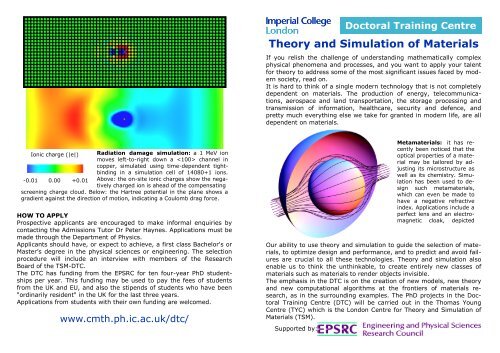Theory and Simulation of Materials
Theory and Simulation of Materials
Theory and Simulation of Materials
You also want an ePaper? Increase the reach of your titles
YUMPU automatically turns print PDFs into web optimized ePapers that Google loves.
Doctoral Training Centre<br />
<strong>Theory</strong> <strong>and</strong> <strong>Simulation</strong> <strong>of</strong> <strong>Materials</strong><br />
If you relish the challenge <strong>of</strong> underst<strong>and</strong>ing mathematically complex<br />
physical phenomena <strong>and</strong> processes, <strong>and</strong> you want to apply your talent<br />
for theory to address some <strong>of</strong> the most significant issues faced by modern<br />
society, read on.<br />
It is hard to think <strong>of</strong> a single modern technology that is not completely<br />
dependent on materials. The production <strong>of</strong> energy, telecommunications,<br />
aerospace <strong>and</strong> l<strong>and</strong> transportation, the storage processing <strong>and</strong><br />
transmission <strong>of</strong> information, healthcare, security <strong>and</strong> defence, <strong>and</strong><br />
pretty much everything else we take for granted in modern life, are all<br />
dependent on materials.<br />
Ionic charge (|e|) Radiation damage simulation: a 1 MeV ion<br />
moves left-to-right down a channel in<br />
copper, simulated using time-dependent tightbinding<br />
in a simulation cell <strong>of</strong> 14080+1 ions.<br />
-0.01 0.00 +0.01 Above: the on-site ionic charges show the negatively<br />
charged ion is ahead <strong>of</strong> the compensating<br />
screening charge cloud. Below: the Hartree potential in the plane shows a<br />
gradient against the direction <strong>of</strong> motion, indicating a Coulomb drag force.<br />
HOW TO APPLY<br />
Prospective applicants are encouraged to make informal enquiries by<br />
contacting the Admissions Tutor Dr Peter Haynes. Applications must be<br />
made through the Department <strong>of</strong> Physics.<br />
Applicants should have, or expect to achieve, a first class Bachelor's or<br />
Master’s degree in the physical sciences or engineering. The selection<br />
procedure will include an interview with members <strong>of</strong> the Research<br />
Board <strong>of</strong> the TSM-DTC.<br />
The DTC has funding from the EPSRC for ten four-year PhD studentships<br />
per year. This funding may be used to pay the fees <strong>of</strong> students<br />
from the UK <strong>and</strong> EU, <strong>and</strong> also the stipends <strong>of</strong> students who have been<br />
"ordinarily resident" in the UK for the last three years.<br />
Applications from students with their own funding are welcomed.<br />
www.cmth.ph.ic.ac.uk/dtc/<br />
Our ability to use theory <strong>and</strong> simulation to guide the selection <strong>of</strong> materials,<br />
to optimize design <strong>and</strong> performance, <strong>and</strong> to predict <strong>and</strong> avoid failures<br />
are crucial to all these technologies. <strong>Theory</strong> <strong>and</strong> simulation also<br />
enable us to think the unthinkable, to create entirely new classes <strong>of</strong><br />
materials such as materials to render objects invisible.<br />
The emphasis in the DTC is on the creation <strong>of</strong> new models, new theory<br />
<strong>and</strong> new computational algorithms at the frontiers <strong>of</strong> materials research,<br />
as in the surrounding examples. The PhD projects in the Doctoral<br />
Training Centre (DTC) will be carried out in the Thomas Young<br />
Centre (TYC) which is the London Centre for <strong>Theory</strong> <strong>and</strong> <strong>Simulation</strong> <strong>of</strong><br />
<strong>Materials</strong> (TSM).<br />
Supported by:<br />
Metamaterials: it has recently<br />
been noticed that the<br />
optical properties <strong>of</strong> a material<br />
may be tailored by adjusting<br />
its microstructure as<br />
well as its chemistry. <strong>Simulation</strong><br />
has been used to design<br />
such metamaterials,<br />
which can even be made to<br />
have a negative refractive<br />
index. Applications include a<br />
perfect lens <strong>and</strong> an electromagnetic<br />
cloak, depicted
THE DTC EXPERIENCE<br />
This DTC will provide a cutting-edge educational <strong>and</strong> research environment<br />
in TSM across length <strong>and</strong> time scales, spanning the disciplines <strong>of</strong><br />
physics, materials, chemistry, aeronautics <strong>and</strong> chemical <strong>and</strong> mechanical<br />
engineering.<br />
The DTC experience is quite unlike an ordinary PhD. There are studentled<br />
seminars <strong>and</strong> conferences, visiting pr<strong>of</strong>essors brought in for students<br />
to interact with, <strong>and</strong> several residential transferable skills<br />
courses. Students receive not only a unique training <strong>and</strong> research experience,<br />
but also opportunities to explore other aspects <strong>of</strong> being a scientist<br />
or engineer such as leadership, decision making, teamwork <strong>and</strong><br />
communication. There are also plenty <strong>of</strong> opportunities to form networks<br />
with students, scientists <strong>and</strong> engineers at other DTCs at Imperial<br />
<strong>and</strong> beyond <strong>and</strong> in industry.<br />
Rubber toughened epoxy adhesives: when the material is stressed (e.g.<br />
at a crack tip), there will be triaxial tensile stresses acting on the rubber particle<br />
due to the different elastic moduli <strong>and</strong> Poisson ratios <strong>of</strong> the rubber particle<br />
<strong>and</strong> the matrix. This leads to cavitation <strong>of</strong> the rubber particles which enables<br />
plastic void growth, <strong>and</strong> hence a large increase in the toughness. Inset:<br />
the stress field.<br />
First-principles quantum-mechanical calculations: when doped with<br />
magnesium TiO 2 forms the cubic MgTi 2 O 4 phase. The electrons donated from<br />
the Mg ion are predicted to localise strongly in particular Ti-d orbitals. The<br />
localised electrons interact strongly to form a beautiful orbitally ordered chiral<br />
spin phase which has been observed in neutron diffraction experiments. The<br />
bonds distort from the cubic structure to form alternating short (purple) <strong>and</strong><br />
long (red) bonds due to the alternating orbital occupancy.<br />
THE MSc COURSE: YEAR 1<br />
The first year is a 12-month, 90-ECTS, Bologna-compliant MSc in the<br />
<strong>Theory</strong> <strong>and</strong> <strong>Simulation</strong> <strong>of</strong> <strong>Materials</strong>. This course provides a foundation<br />
in theoretical materials physics <strong>and</strong> its applications in simulations<br />
across length <strong>and</strong> time scales.<br />
There are six core courses:<br />
Mathematical <strong>and</strong> Computational Methods<br />
Equilibrium in <strong>Materials</strong><br />
Change in <strong>Materials</strong><br />
Electronic Structure <strong>of</strong> <strong>Materials</strong><br />
Elasticity <strong>and</strong> Microplasticity<br />
<strong>Materials</strong> <strong>Simulation</strong> Methods from Electrons to Finite Elements<br />
Students will also select two options in the first year <strong>and</strong> may take further<br />
options in later years. For both the core courses <strong>and</strong> options, the<br />
teaching involves a mix <strong>of</strong> lectures, directed reading, problem classes,<br />
computational exercises <strong>and</strong> seminars. Assessment is by a combination<br />
<strong>of</strong> coursework <strong>and</strong> written examinations.













